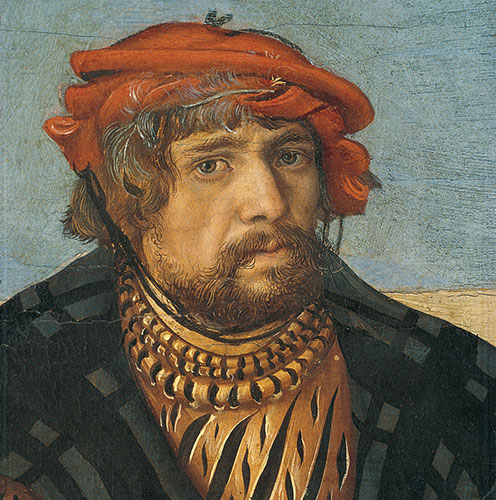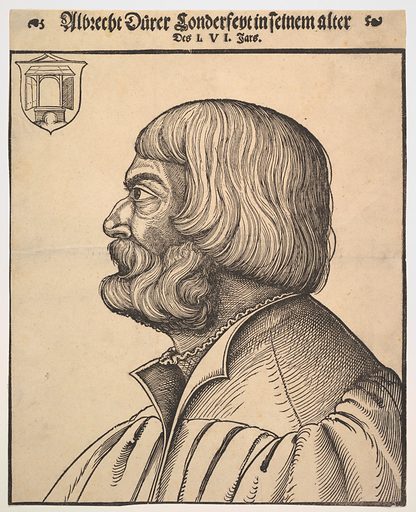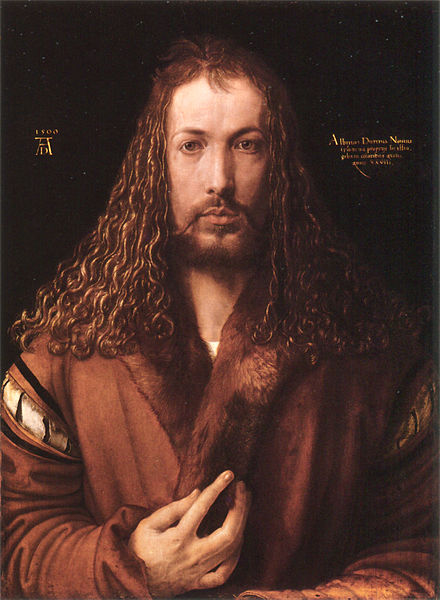The Lutheran Artists
The saints Lucas Cranach and Albrecht Dürer were significant figures not only within the life of the Church but also the landscape of the German Renaissance. They are famous for their painting and engraving during some of the most pivotal and dynamic years of German history. Together these men are remembered as the most famous of Lutheran artists, using their craft to communicate the most important values of the Reformation to believers and nonbelievers alike.
St. Lucas Cranach the Elder

St. Lucas Cranach lived from October 4, 1472 to October 16, 1553 and was born in Kronach (the source of his name). His father was an artist and he grew up learning the craft—he was invited in 1504 to be the Wittenberg court artist for the Elector of Saxony, Frederick the Wise. Within four years of his working for the court he was knighted, praised for his services and fulfillment of various duties including his painting of portraits of religious and political heads, religious and mythological pieces, murals, creation of decor for court events, printmaking, clothes design, glass blowing, furniture making, and furnishing of medals, coins, and ornaments. To meet these great demands, Cranach had a large studio full of other artists, students, and craftsmen that worked for him.
Part of these understudies included his son: St. Lucas Cranach is in part known for being one half of a father-and-son team that consisted of him, Lucas Cranach the Elder and his son, Lucas Cranach the Younger. Together and through their work for the court, they were considered two of the greatest Reformation-era painters.
The newly founded Wittenberg University brought St.Martin Luther into Cranach’s orbit. They became dear friends with Cranch standing as the best man at Luther’s wedding to Katharina von Bora and both of them were godparents to each others’ children. Cranach memorialized the pair in double wedding portraits of the couple, perhaps the most famous pictures of them to this day. When Luther went into hiding in 1521, Cranach was one of the few with whom Luther kept in touch. They would be tied together throughout the rest of their lives.

When looking at Cranach’s work, there is certainly a tasteful simplicity to his art. However, there is much more than expected that lies beneath the surface; his productions showcase much of the tensions of the northern Renaissance fights for balance between spirit and body, God and flesh, good and evil, humanity and nature. While he originally painted religious subjects in the Catholic tradition, later on in his life he tried to find new ways of conveying the tenets of Lutheran theology in his art. All in all, Cranach is seen to embody the Reformation, not only in his personhood and through those he interacted with as part of his inner circle, but also through the contours of his craft.
St. Albrecht Dürer

St. Albrecht Dürer was born in Nuremberg on May 21, 1471 and, like Cranach, was recognized at an early age for his artistic talent. He became an apprentice to a local painter in his teens before starting his early adulthood by traveling around Europe and marrying his wife, with whom he would have no children.
Inspired by both the Gothic and Italian Renaissance styles, Dürer traveled often to gain inspiration and learn new abilities, earning great fame around Germany and Europe. Printmaking was perhaps one of his most highly admired abilities. He worked for Emperor Maxmillian I briefly and was also well associated with many of the other most distinguished people of his time.
Deeply religious, St. Dürer kept a close eye on the Reformation and was an ardent admirer of Martin Luther, even though he sadly never met him. He produced numerous portraits of religious figures and Biblical depictions, which still stand as some of his most famous works. Towards the end of his life, he gave the Nuremberg city council his painting of the Four Apostles, which included quotations from Luther’s translation of the Bible. Dying on April 6, 1528, he gave us the date of the commemoration for both these saints who are often talked about in tandem with one another. His paintings showcase his contemplation of many of the greatest issues of his day including famine, plague, and social and religious upheaval.

A Brief History
Together these men comprise two of the most famous Lutheran artists of all time, remembered far past the time of the Reformation not only for their success but also their dedication to depicting the faith and new Lutheran religious identity through their craft. By perfecting their forms and using their talents not only to paint famous Lutheran Reformers, such as Martin Luther and Philip Melachton, but also spread the Gospel across all of Europe, Ss. Cranach and Dürer are well deserving of their placement within the Lutheran sanctoral calendar.
Their work has even had great influence on Lutheranism today—we at All the Household have used their work in many (if not most) of the blog posts we have on this website and other Lutheran artists that have come after their time have cited them as great inspiration for their work as well.
Martin Luther himself greatly valued the role of religious art in spreading the Gospel (reasons for which we discuss in this post). He is quoted as saying (in a passage many Lutherans use for Ss. Cranach and Durer’s commemoration):
“Who can exhaust all the virtue and power of God’s Word? The Holy Scriptures, sermons, and all Christian books do nothing but praise God’s Word, as we also do daily in our reading, writing, preaching, singing, poetizing, and in painting. This blessing abides and sustains us when the temporal blessings vanish and when through death we part from them and from one another. This blessing does not leave us or depart from us; it goes through death with us, tears us out of it, and brings us to eternal life, where there is neither death nor fear of dying.”
– Martin Luther
Collect
O Almighty God, who hast knit together Thine elect in one communion and fellowship in the mystical body of Thy Son Jesus Christ, our Lord: grant us grace so to follow Thy blessed saints in all virtuous and godly living, that we may come to the unspeakable joys which Thou hast prepared for those who unfeignedly love Thee; through the same, Jesus Christ, Thy Son, our Lord, who liveth and reigneth with Thee and the Holy Ghost: ever one God, world without end. Amen.
Lessons
Resources
Issues, Etc. interview with the Dr. Gene Edward Veith on Christianity and the Arts, Reformation Artists Lucas Cranach & Albrecht Dürer
Issues, Etc. interview with Kelly Schumacher on Reformation Artists Albrecht Dürer and Lucas Cranach

Propers found in Daily Divine Service Book: A Lutheran Daily Missal, edited by the Rev. Heath Curtis
References:
1. Weedon, William. Celebrating the Saints. Concordia Publishing House. 2016.
2. Brinkley, Carolyn. “Cranach’s ‘Let the Little Children Come to Me’.” Lutheran Church Missouri Synod Resources. 2017.
Images:
1. Lucas Cranach, Unknown, 19th century, Germany.
2. Self-Portrait, Lucas Cranach the Elder, 1509/10, Germany.
3. Portrait of Albrecht Dürer, Erhard Schön, ca. 16th century, Germany.
4. Self-Portrait, Albrecht Dürer, 1500, Germany.



[…] art of the Lutheran Artists, Ss. Lucas Cranach and Albrecht Dürer are some of the greatest cultural contributions we have that belong to the Lutheran faith and […]